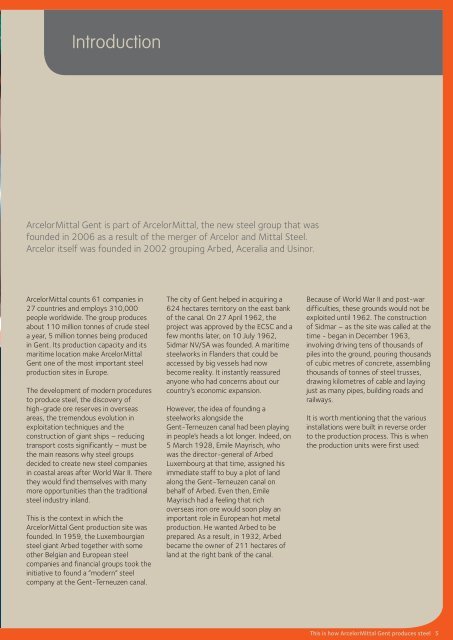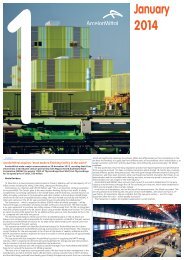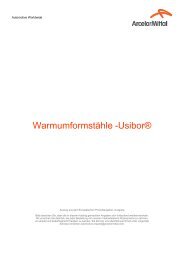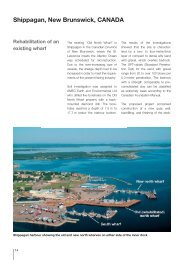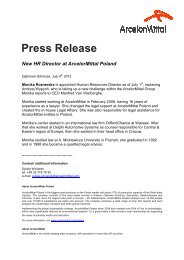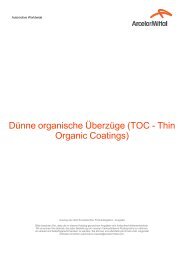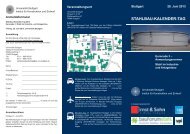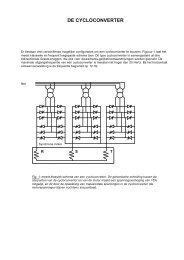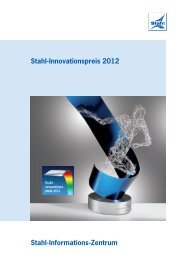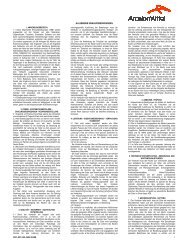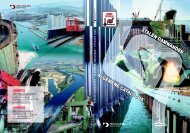This is how ArcelorMittal Gent produces steel
This is how ArcelorMittal Gent produces steel
This is how ArcelorMittal Gent produces steel
Create successful ePaper yourself
Turn your PDF publications into a flip-book with our unique Google optimized e-Paper software.
Introduction<br />
<strong>ArcelorMittal</strong> <strong>Gent</strong> <strong>is</strong> part of <strong>ArcelorMittal</strong>, the new <strong>steel</strong> group that was<br />
founded in 2006 as a result of the merger of Arcelor and Mittal Steel.<br />
Arcelor itself was founded in 2002 grouping Arbed, Aceralia and Usinor.<br />
<strong>ArcelorMittal</strong> counts 61 companies in<br />
27 countries and employs 310,000<br />
people worldwide. The group <strong>produces</strong><br />
about 110 million tonnes of crude <strong>steel</strong><br />
a year, 5 million tonnes being produced<br />
in <strong>Gent</strong>. Its production capacity and its<br />
maritime location make <strong>ArcelorMittal</strong><br />
<strong>Gent</strong> one of the most important <strong>steel</strong><br />
production sites in Europe.<br />
The development of modern procedures<br />
to produce <strong>steel</strong>, the d<strong>is</strong>covery of<br />
high-grade ore reserves in overseas<br />
areas, the tremendous evolution in<br />
exploitation techniques and the<br />
construction of giant ships – reducing<br />
transport costs significantly – must be<br />
the main reasons why <strong>steel</strong> groups<br />
decided to create new <strong>steel</strong> companies<br />
in coastal areas after World War II. There<br />
they would find themselves with many<br />
more opportunities than the traditional<br />
<strong>steel</strong> industry inland.<br />
<strong>Th<strong>is</strong></strong> <strong>is</strong> the context in which the<br />
<strong>ArcelorMittal</strong> <strong>Gent</strong> production site was<br />
founded. In 1959, the Luxembourgian<br />
<strong>steel</strong> giant Arbed together with some<br />
other Belgian and European <strong>steel</strong><br />
companies and financial groups took the<br />
initiative to found a “modern” <strong>steel</strong><br />
company at the <strong>Gent</strong>-Terneuzen canal.<br />
The city of <strong>Gent</strong> helped in acquiring a<br />
624 hectares territory on the east bank<br />
of the canal. On 27 April 1962, the<br />
project was approved by the ECSC and a<br />
few months later, on 10 July 1962,<br />
Sidmar NV/SA was founded. A maritime<br />
<strong>steel</strong>works in Flanders that could be<br />
accessed by big vessels had now<br />
become reality. It instantly reassured<br />
anyone who had concerns about our<br />
country’s economic expansion.<br />
However, the idea of founding a<br />
<strong>steel</strong>works alongside the<br />
<strong>Gent</strong>-Terneuzen canal had been playing<br />
in people’s heads a lot longer. Indeed, on<br />
5 March 1928, Emile Mayr<strong>is</strong>ch, who<br />
was the director-general of Arbed<br />
Luxembourg at that time, assigned h<strong>is</strong><br />
immediate staff to buy a plot of land<br />
along the <strong>Gent</strong>-Terneuzen canal on<br />
behalf of Arbed. Even then, Emile<br />
Mayr<strong>is</strong>ch had a feeling that rich<br />
overseas iron ore would soon play an<br />
important role in European hot metal<br />
production. He wanted Arbed to be<br />
prepared. As a result, in 1932, Arbed<br />
became the owner of 211 hectares of<br />
land at the right bank of the canal.<br />
Because of World War II and post-war<br />
difficulties, these grounds would not be<br />
exploited until 1962. The construction<br />
of Sidmar – as the site was called at the<br />
time - began in December 1963,<br />
involving driving tens of thousands of<br />
piles into the ground, pouring thousands<br />
of cubic metres of concrete, assembling<br />
thousands of tonnes of <strong>steel</strong> trusses,<br />
drawing kilometres of cable and laying<br />
just as many pipes, building roads and<br />
railways.<br />
It <strong>is</strong> worth mentioning that the various<br />
installations were built in reverse order<br />
to the production process. <strong>Th<strong>is</strong></strong> <strong>is</strong> when<br />
the production units were first used:<br />
<strong>Th<strong>is</strong></strong> <strong>is</strong> <strong>how</strong> <strong>ArcelorMittal</strong> <strong>Gent</strong> <strong>produces</strong> <strong>steel</strong> 5


